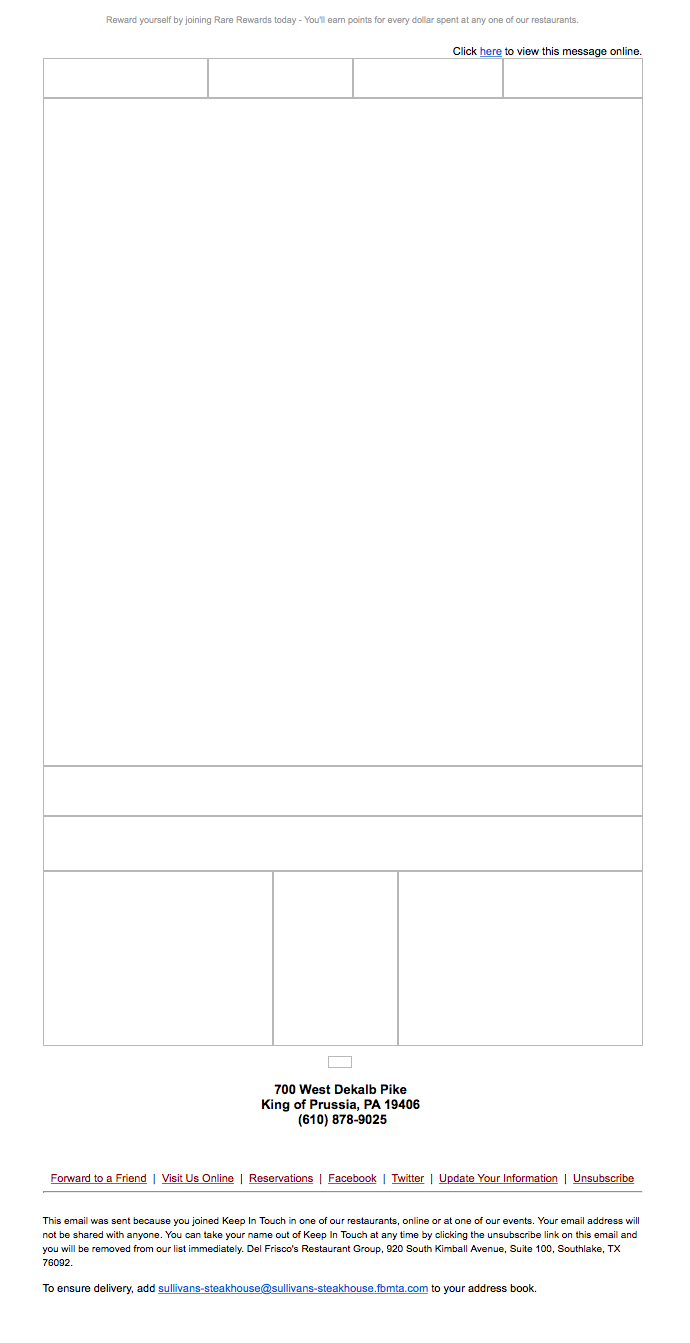Rare Rewards Email Review: Does It Make You Want to Join the Program?
Rare Rewards Email Grade: [B-]
Subject Line & Preheader | 5 |
Preview Pane | 1 |
Eye Path | 3 |
Clarity of Message | 4 |
Call to Action | 4 |
Offer & Urgency | 4 |
Congruency | 5 |
Email grades are based on a 5-point scale: A = 5, B = 4, C = 3, D = 2, F = 1
March 7, 2017 –
Organization Overview
Rare Rewards is a program that gives a point to its members for each dollar that they spend at any of the following restaurant chains: Del Frisco’s, Sullivan’s, and Del Frisco’s Grille. These restaurants have locations across the United States, and their loyal customers can sign up for the Rare Rewards program online or in store. There is a one-time fee of $25 that is loaded on a new member’s Rare Rewards account upon registration.
Strong Subject Line and Preheader Attract High-Quality Openers
The subject line of this email—”NEW! Join Rare Rewards Now”—is a strong one. Putting “NEW!” in uppercase and combining it with an exclamation point not only conveys energy and excitement, but also helps the subject line stand out in the inbox. Plus, ending the line with “Now” helps create a sense of urgency.
The preheader follows up with more important details about the restaurant rewards program and what’s in it for Rare Rewards members: “Reward yourself by joining Rare Rewards today. You’ll earn points for every dollar spent at any one of our restaurants.” This winning combination of a strong subject line and informative preheader drives high-quality openers—people who are more likely to join the rewards program.
Room for Improvement in the Preview Pane and Eye Path
No alternative text is used in the preview pane without images, so only big blocks of empty space are displayed. There’s no call to action and nothing to entice recipients to download the images.
The design is clean and the eye path draws attention from the headline, down through the bullets, to the two call-to-action buttons. Although the phone located on the right half of the email contains a lot of important information about the rewards program, it draws attention away from the concisely written bullets and the call-to-action buttons.
Competing Call-to-Action Buttons
Recipients are given the choice of two calls to action: “Join Now” and “More Information.” Because the buttons are the same size and color, they compete with each other. It’s a great idea to provide recipients with a link to get more information about the rewards program—especially because they are required to pay a $25 fee to join—but the primary call to action should be to join the program. So, perhaps the design of the “Join Now” button could be bigger or a brighter color to stand out compared to the call-to-action for more information. Or a simple text link could be used to provide more information.
The message of this email—the Rare Rewards program offer and how to join—is clear. There’s also congruency between the subject line and preheader and the email’s headline, copy, and call to action. And including the logos of restaurants at the bottom of the email is a highly effective way to let recipients know which chains participate in this rewards program. If the important information covered in the first two bullets was displayed more prominently, however, recipients could more quickly see the major benefits of joining the rewards program.
Email Message Lacks a Sense of Urgency
There’s a missed opportunity in that this email message has no sense of urgency. For example, setting a deadline to join and giving an incentive to do so (e.g., reward points or waive the fee to join) would likely drive more clicks.
Using email marketing to spread the word about customer loyalty programs can be an effective way to engage with, and increase revenue from, existing customers. This email from Rare Rewards is a good example. With a few tweaks—such as using alternative text for the images, adding a sense of urgency, and crafting a prominent and primary call to action—this email would likely get even more clicks and conversions.
Disclaimer: FulcrumTech does not have access to the performance data relating to this promotional email, so any tests performed on this email can’t be reflected in FulcrumTech’s commentary.


